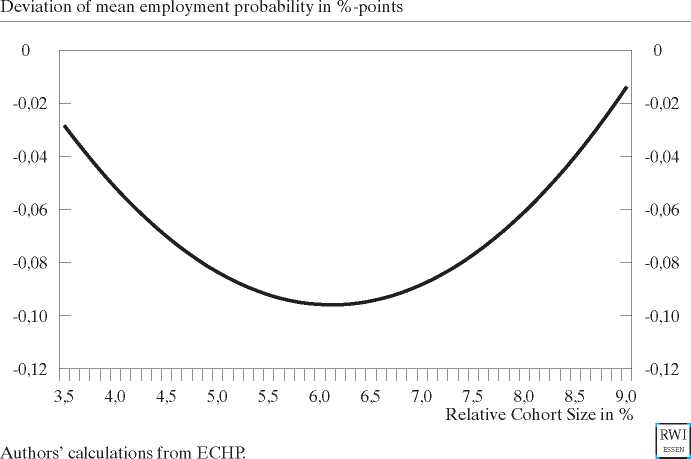28
Michael Fertig and Christoph M. Schmidt
Figure 7
Cohort Size-Employment Probability Profile

sults differ considerably for different cohort sizes. While the marginal effect of
increasing cohort size on employment propensities is strongly negative when
cohort size is small, it increases with growing cohort size. At the mean cohort
size (around 7 %), the employment probability is rising by 0.04 percentage
points for each 1 percentage point increase in cohort size (for the complete
sample). Overall, the estimates suggest an u-shaped relationship between the
individual employment probability and the size of one’s own cohort.
Within our sample relative cohort sizes vary between 3.9 % and 8.8 %.
Figure 7 depicts the relationship between cohort sizes and employment proba-
bility for cohort sizes from 3.5 % to 9 %. This figure indicates that for small co-
horts the employment probability is falling with increasing cohort size but for
cohorts larger than approximately 6 % of the total population it increases
again. This, at first glance, rather striking result indicates that larger cohorts
are able to exert enough influence or otherwise unfold activities to mitigate
the negative labor market consequences of generational crowding. The pre-
cise nature of these processes will certainly present an interesting area for fur-
ther research.
Ifwe had not controlled for the education structure of the cohort of each sur-
vey, respondent, our results regarding the effect of cohort size would have
More intriguing information
1. Behavioural Characteristics and Financial Distress2. Willingness-to-Pay for Energy Conservation and Free-Ridership on Subsidization – Evidence from Germany
3. Review of “From Political Economy to Economics: Method, the Social and Historical Evolution of Economic Theory”
4. A COMPARATIVE STUDY OF ALTERNATIVE ECONOMETRIC PACKAGES: AN APPLICATION TO ITALIAN DEPOSIT INTEREST RATES
5. Picture recognition in animals and humans
6. The name is absent
7. The name is absent
8. Dendritic Inhibition Enhances Neural Coding Properties
9. Insecure Property Rights and Growth: The Roles of Appropriation Costs, Wealth Effects, and Heterogeneity
10. SOME ISSUES IN LAND TENURE, OWNERSHIP AND CONTROL IN DISPERSED VS. CONCENTRATED AGRICULTURE